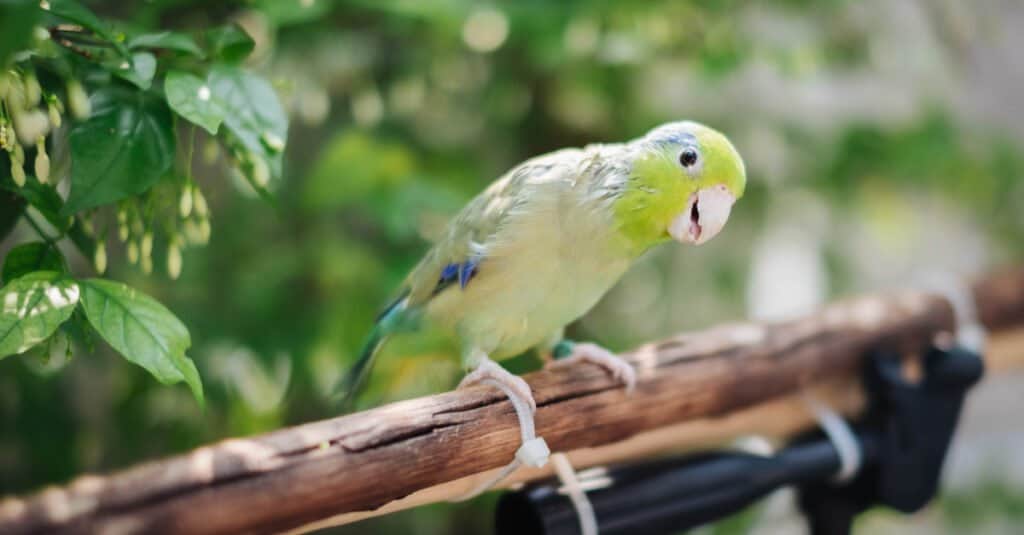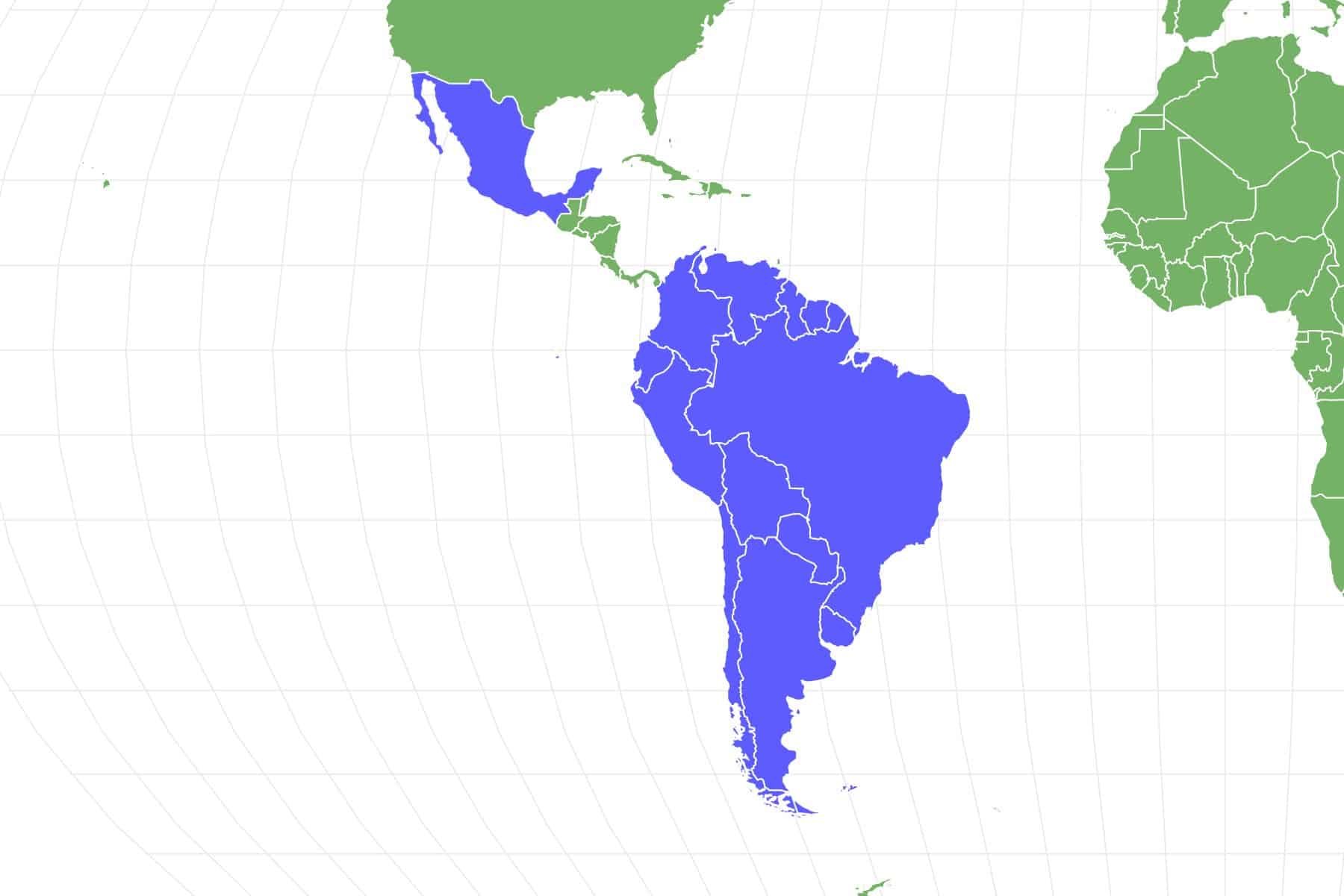Parrotlet
Forpus cyanopygius
Parrotlets aren't the world's tiniest parrot — that would be the pygmy parrot of Australasia.
Advertisement
Parrotlet Scientific Classification
- Kingdom
- Animalia
- Phylum
- Chordata
- Class
- Aves
- Order
- Psittaciformes
- Family
- Psittacidae
- Genus
- Forpus
- Scientific Name
- Forpus cyanopygius
Read our Complete Guide to Classification of Animals.
Parrotlet Conservation Status
Parrotlet Facts
- Prey
- Occasionally insects
- Fun Fact
- Parrotlets aren't the world's tiniest parrot — that would be the pygmy parrot of Australasia.
- Estimated Population Size
- Tens of thousands, conservatively
- Biggest Threat
- Habitat disruption, illegal parrotlet trade
- Most Distinctive Feature
- Their colorful feathers
- Other Name(s)
- Pocket parrot
- Temperament
- Feisty, affectionate, sometimes aggressive
- Wingspan
- 6 inches on average
- Litter Size
- Three to seven
- Habitat
- Savannas, riverine forests scrubland, pastures, gallery forests, palm groves, deserts, gardens, tropical and subtropical forests
- Predators
- Birds of prey, big cats, bats, monkeys, and snakes
- Diet
- Omnivore
- Type
- Bird
- Common Name
- Parrotlets
- Location
- Places of origin are Mexico, South and Central America
- Age of Molting
- 29 to 35 days
View all of the Parrotlet images!
“The Smallest of the New World Parrots”
Parrotlets are even smaller in size than parakeets. They have blunt tails and a feisty personality that can be aggressive. They can even deliver a surprisingly painful bite. A pet parrotlet is less social than a parakeet, though it can bond very intensely with a mate or its human. Read on for more information about this little “pocket parrot.”
5 Incredible Parrotlet Facts!
- The parrotlet is a talking bird, though it doesn’t mimic speech as well as a larger parrot such as the African gray parrot. The pricey spectacled parrotlet is famous for having better-than-average talking skills.
- Parrotlets cost much more than parakeets, and they are harder to find in pet stores. This bird can cost more than $1000, while a Budgie rarely costs more than $60.
- A parrotlet’s pugnacious personality might let it think it can best a pet dog or cat. It can’t, and owners should be aware of this and make sure their parrotlet is supervised whenever it’s let out of its cage.
- Whether blue-winged, scarlet-shouldered, or green-rumped, parrotlets possess four-toed zygodactyl feet. This means two of their toes point forward and the other two point backward. This helps them maintain a tight grip on a branch.
- The Manu parrotlet is known for visiting clay licks in its countries of origin, Peru, Bolivia and Brazil. There, it gets needed minerals such as sodium. The scarlet-shouldered and spectacled parrotlets also visit clay licks.
Parrotlets vs. Parakeets
Unlike a parakeet, the parrotlet has a short tail. It also has a stockier build. Owners will also find that a parrotlet’s personality is different from the playful and affectionate personality of a parakeet. These birds can be affectionate, but they can also be aggressive and ready to bite. Unlike the gregarious parakeet, they prefer to be kept apart from other birds in captivity, even their conspecifics (members of the same species). Even mated pairs have been known to fight to the death. Parrotlets also don’t reproduce as well in captivity as parakeets.
Where To Find Parrotlets
The two most popular parrotlets, the Pacific and green-rumped parrotlets, can be found in some pet stores. Parrotlets that have been bred to develop spectacular colors (or in the case of albino parrotlets, no colors) can be purchased from breeders. The potential owner needs to make sure that the breeders are reputable, that it is legal to buy and sell the parrotlets, and that the birds are healthy.
Scientific Names
These birds belong to four genera. They are Forpus, Touit, and Nannopsittaca. Touit is interesting because it is derived from neither Greek nor Latin. Instead, it comes from the Tupi language for “very little parrot.” The Tupi people are native to Brazil. Nannopsittaca comes from the Greek and Latin words for “dwarf” which is nanus and the Greek word for parrot, which is psittakos.
There are about nine species in Forpus, seven species in Touit, and only two species in Nannopsittaca. Many of these species, such as the Mexican parrotlet and the green-rumped parrotlet have subspecies, though the lilac-tailed parrotlet, whose origins are in Trinidad and Tobago and northeast South America, is monotypic. Some species are:
- Forpus coelestis
- Forpus spengeli
- Touit huetii
- Nannopsittaca panychlora
- Touit surdus
Appearance
In general, these birds are smaller than parakeets and much smaller in size than their cousin, the Amazon parrot. They have short — even stubby — tails that make them look chunkier than the parakeet. Males can be easy to discern from females by their plumage. However, the species of parrotlet determines the colors of their feathers.
The male of the popular Pacific parrotlet is a blue-winged bird that also has some blue behind its eyes and on its rump. The female does not have a blue streak behind the eyes. Another blue-winged parrotlet is the turquoise-winged parrotlet, whose males not only have rich turquoise on their wings but also on their rumps and the lower part of their backs. Females do not have blue feathers but the yellow-green of their faces is brighter than that of the males.

©Redhatz69/Shutterstock.com
Behavior
In the wild, these birds are very gregarious and can form flocks made up of dozens. They are noisy as they fly, even though individual parrotlets are known for their soft voices. Ironically, it is sometimes hard for one to tolerate another bird in its cage, especially if the cage is small.
Diet
In the wild, these birds eat fruit, berries, seeds, nuts, and sometimes grass. Owners need to make sure that the diet of their birds gives them the nutrients that they need. They can make seed mixes that have ingredients such as sunflower, millet, and other seeds, offer fresh fruit and green leafy vegetables every day and feed the birds pellets that are designed to give them essential vitamins and minerals. Of course, clean, fresh water is a must, especially during hot summers.
Predators and Threats
Since they are such small birds, it is reasonable to think that parrotlets would frequently fall prey to predators, especially those that live in the forests of Mexico and Central and South America such as jaguars. However, because the birds flock in such high numbers, it can be difficult for a predator to hone in on one individual. Like most birds, parrotlet hatchlings are most at risk for predation.
Predators include carnivores such as the ocelot, snakes, hawks, other birds of prey, and bats that can grow even larger than adult birds. Some species are trapped for the pet trade, even though it is illegal. The number of birds that die before they can be sold can be calamitous. Because they are curious and somewhat belligerent, they are at risk for accidents and confrontations if they are let out of their cage without the owner keeping an eye on them.
Reproduction, Babies, and Lifespan
Most parrotlets mate for life and breed during the rainy season. Some, such as the Mexican parrotlet, nest in tree or cactus cavities. They may also take over the abandoned nests of other birds. Females lay one egg a day or every other day until she has three to seven. The eggs are small and white, and she incubates them exclusively, though the male feeds her and the chicks. The eggs hatch after 18 to 22 days — again, one at a time. The chicks fledge after a month or so and are ready to leave the nest a few weeks after that, though brothers and sisters may stay in touch with each other. The lifespan of a cared-for pet parrotlet can be as long as 30 years.
An owner should know that some parrotlets, such as the spectacled parrotlet, can no longer be handled once it has bonded with a mate.
Population
The population of the Amazonia parrotlet is believed to be between 2500 and 9999 birds alone. The population of most parrotlets is either steady or decreasing, though most species are listed as of least concern.
View all 192 animals that start with PParrotlet FAQs (Frequently Asked Questions)
Are parrotlets a good pet for companionship?
Parrotlets are generally more solitary than other small parrot species that are often kept as pets. For example, the primary difference between parrotlets and parakeets is that parakeets have a greater need for companionship.
Do Parrotlets Migrate?
Parrotlets don’t migrate though they can travel from one part of their habitat to another to find food.
How many eggs does a Parrotlet lay?
Parrotlets lay from three to seven eggs depending on the species.
How fast does a Parrotlet fly?
A parrotlet can fly around 40 miles per hour.
What is a Parrotlet’s Wingspan?
The parrolet’s wingspan is about 6 inches.
When do Parrotlets leave the nest?
Parrotlets leave the nest when they’re probably two to three months old.
Is a parrotlet a good pet?
A parrotlet can be a good pet if it is given lots of care and attention. A parrotlet left alone for much of the time can start to bite and become neurotic and destructive.
Do parrotlets like to be held?
Parrotlets like to be held if they have been handled regularly since they were very young. Some birds can be trained to snuggle in their owner’s shirt pocket and poke their head out once in a while.
How much do parrotlets cost?
Parrotlets are expensive compared to parakeets. A parrotlet can cost over $1000.
Are parrotlets good beginner birds?
Parrotlets may be good beginner birds for people who can pay a lot of attention to them and give them good care.
What is a parrotlet?
A parrotlet is a very small parrot. It is smaller than a parakeet but more closely related to the Amazon parrots.
Where can you buy a parrotlet?
Some pet stores sell parrotlets, but parrotlets are also bought from reputable breeders.
How do you care for a parrotlet?
Parrotlets need to be gently handled by their owner daily, given nutritionally balanced meals that consist of seeds, nuts, fruits, green leafy vegetables, pellets and fresh water. They should also be given a cuttlebone and a place to bathe now and then. Their cage should be as large as is practicable since these birds are active and like to fly around.
How do you train a parrotlet?
Though a parrotlet’s talking skills aren’t as developed as those of a large parrot or even a parakeet, it can be trained to say a few words. Always reward the bird with praise and a treat if it repeats a word back to you.
Thank you for reading! Have some feedback for us? Contact the AZ Animals editorial team.
Sources
- thesprucePets, Available here: https://www.thesprucepets.com/facts-about-parrotlets-390924
- Wikipedia, Available here: https://en.wikipedia.org/wiki/Spectacled_parrotlet
- Lafeber Company, Available here: https://lafeber.com/pet-birds/species/parrotlet/
- Avian Enrichment, Available here: https://avianenrichment.com/learn/instinctual-needs/security/parrots-and-predators
- Bird Life International, Available here: http://datazone.birdlife.org/species/factsheet/amazonian-parrotlet-nannopsittaca-dachilleae
- Parrots of the Americas, Available here: https://www.parrotfunzone.com/explore-parrots/parrots-in-the-wild/where-do-parrots-come-from/parrots-of-the-americas

















